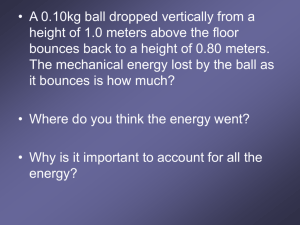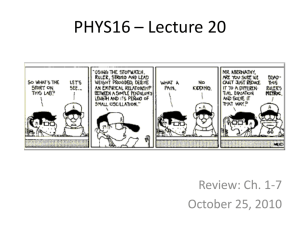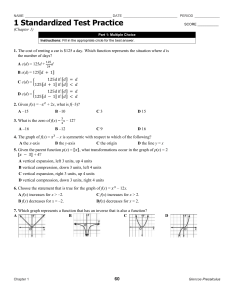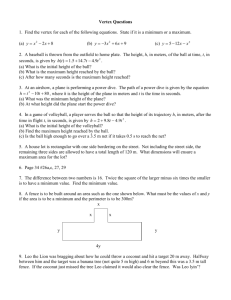Work Power and energy FRQ Handout
advertisement
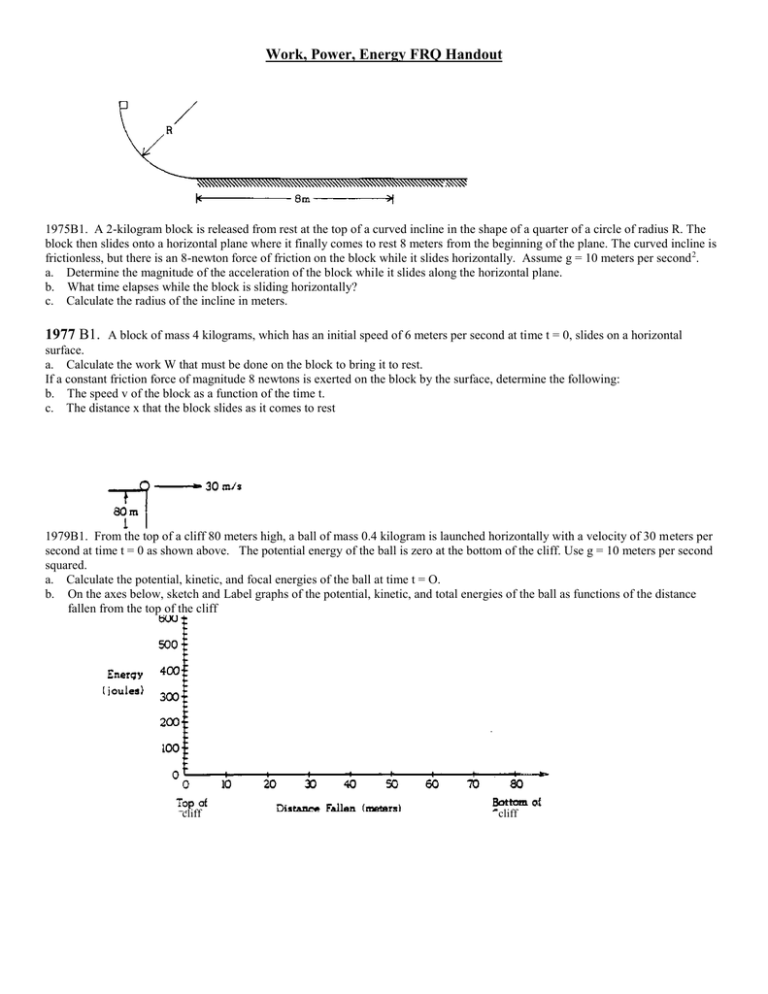
Work, Power, Energy FRQ Handout 1975B1. A 2-kilogram block is released from rest at the top of a curved incline in the shape of a quarter of a circle of radius R. The block then slides onto a horizontal plane where it finally comes to rest 8 meters from the beginning of the plane. The curved incline is frictionless, but there is an 8-newton force of friction on the block while it slides horizontally. Assume g = 10 meters per second 2. a. Determine the magnitude of the acceleration of the block while it slides along the horizontal plane. b. What time elapses while the block is sliding horizontally? c. Calculate the radius of the incline in meters. 1977 B1. A block of mass 4 kilograms, which has an initial speed of 6 meters per second at time t = 0, slides on a horizontal surface. a. Calculate the work W that must be done on the block to bring it to rest. If a constant friction force of magnitude 8 newtons is exerted on the block by the surface, determine the following: b. The speed v of the block as a function of the time t. c. The distance x that the block slides as it comes to rest 1979B1. From the top of a cliff 80 meters high, a ball of mass 0.4 kilogram is launched horizontally with a velocity of 30 meters per second at time t = 0 as shown above. The potential energy of the ball is zero at the bottom of the cliff. Use g = 10 meters per second squared. a. Calculate the potential, kinetic, and focal energies of the ball at time t = O. b. On the axes below, sketch and Label graphs of the potential, kinetic, and total energies of the ball as functions of the distance fallen from the top of the cliff cliff cliff c. On the axes below sketch and label the kinetic and potential energies of the ball as functions of time until the ball hits 1981B1. A 10-kilogram block is pushed along a rough horizontal surface by a constant horizontal force F as shown above. At time t = 0, the velocity v of the block is 6.0 meters per second in the same direction as the force. The coefficient of sliding friction is 0.2. Assume g = 10 meters per second squared. a. Calculate the force F necessary to keep the velocity constant. The force is now changed to a Larger constant value F'. The block accelerates so that its kinetic energy increases by 60 joules while it slides a distance of 4.0 meters. b. Calculate the force F'. c. Calculate the acceleration of the block. 1982B3. A child of mass M holds onto a rope and steps off a platform. Assume that the initial speed of the child is zero. The rope has length R and negligible mass. The initial angle of the rope with the vertical is o, as shown in the drawing above. a. Using the principle of conservation of energy, develop an expression for the speed of the child at the lowest point in the swing in terms of g, R, and cos o b. The tension in the rope at the lowest point is 1.5 times the weight of the child. Determine the value of cos o. 1985B2. Two 10-kilogram boxes are connected by a massless string that passes over a massless frictionless pulley as shown above. The boxes remain at rest, with the one on the right hanging vertically and the one on the left 2.0 meters from the bottom of an inclined plane that makes an angle of 60° with the horizontal. The coefficients of kinetic friction and static friction between the Ieft-hand box and the plane are 0.15 and 0.30, respectively. You may use g = 10 m/s 2, sin 60° = 0.87, and cos 60° = 0.50. a. What is the tension T in the string? b. On the diagram below, draw and label all the forces acting on the box that is on the plane. c. Determine the magnitude of the frictional force acting on the box on the plane. The string is then cut and the left-hand box slides down the inclined plane. d. Determine the amount of mechanical energy that is converted into thermal energy during the slide to the bottom. e. Determine the kinetic energy of the left-hand box when it reaches the bottom of the plane. 1986B2. One end of a spring is attached to a solid wall while the other end just reaches to the edge of a horizontal, frictionless tabletop, which is a distance h above the floor. A block of mass M is placed against the end of the spring and pushed toward the wall until the spring has been compressed a distance X, as shown above. The block is released, follows the trajectory shown, and strikes the floor a horizontal distance D from the edge of the table. Air resistance is negligible. Determine expressions for the following quantities in terms of M, X, D, h, and g. Note that these symbols do not include the spring constant. a. b. c. d. The time elapsed from the instant the block leaves the table to the instant it strikes the floor The horizontal component of the velocity of the block just before it hits the floor The work done on the block by the spring The spring constant 1988B2. A ball thrown vertically downward strikes a horizontal surface with a speed of 15 meters per second. It then bounces, and reaches a maximum height of 5 meters. Neglect air resistance on the ball. a. What is the speed of the ball immediately after it rebounds from the surface? b. What fraction of the ball's initial kinetic energy is apparently lost during the bounce? c. If the specific heat of the ball is 1,800 J/kg °C, and if all of the lost energy is absorbed by the molecules of the ball, by how much does the temperature of the ball increase? 1992B1. A 0. 10-kilogram solid rubber ball is attached to the end of an 0.80-meter length of light thread. The ball is swung in a vertical circle, as shown in the diagram above. Point P, the lowest point of the circle, is 0.20 meter above the floor. The speed of the ball at the top of the circle is 6.0 meters per second, and the total energy of the ball is kept constant. a. Determine the total energy of the ball, using the floor as the zero point for gravitational potential energy. b. Determine the speed of the ball at point P, the lowest point of the circle. c. Determine the tension in the thread at i. the top of the circle; ii. the bottom of the circle. The ball only reaches the top of the circle once before the thread breaks when the ball is at the lowest point of the circle. d. Determine the horizontal distance that the ball travels before hitting the floor. 1994B2. A track consists of a frictionless arc XY, which is a quarter-circle of radius R, and a rough horizontal section YZ. Block A of mass M is released from rest at point X, slides down the curved section of the track, and collides instantaneously and inelastically with identical block B at point Y. The two blocks move together to the right, sliding past point P, which is a distance l from point Y. The coefficient of kinetic friction between the blocks and the horizontal part of the track is Express your answers in terms of M, l, , R, and g. a. Determine the speed of block A just before it hits block B. b. Determine the speed of the combined blocks immediately after the collision. c. Determine the amount of kinetic energy lost due to the collision. d. The specific heat of the material used to make the blocks is c. Determine the temperature rise that results from the collision in terms of c and the other given quantities. (Assume that no energy is transferred to the track or to the air surrounding the blocks.) e. Determine the additional thermal energy that is generated as the blocks move from Y to P 1996B2 (15 points) A spring that can be assumed to be ideal hangs from a stand, as shown above. a. You wish to determine experimentally the spring constant k of the spring. i. What additional, commonly available equipment would you need? ii. What measurements would you make? iii. How would k be determined from these measurements? b. Assume that the spring constant is determined to be 500 N/m. A 2.0-kg mass is attached to the lower end of the spring and released from rest. Determine the frequency of oscillation of the mass. c. Suppose that the spring is now used in a spring scale that is limited to a maximum value of 25 N, but you would like to weigh an object of mass M that weighs more than 25 N. You must use commonly available equipment and the spring scale to determine the weight of the object without breaking the scale. i. Draw a clear diagram that shows one way that the equipment you choose could be used with the spring scale to determine the weight of the object, ii. Explain how you would make the determination. 1998B3 (10 points) Students are designing an experiment to demonstrate the conversion of mechanical energy into thermal energy. They have designed the apparatus shown in the figure above. Small lead beads of total mass M and specific heat c fill the lower hollow sphere. The valves between the spheres and the hollow tube can be opened or closed to control the flow of the lead beads. Initially both valves are open. a. The lower valve is closed and a student turns the apparatus 180° about a horizontal axis, so that the filled sphere is now on top. This elevates the center of mass of the lead beads by a vertical distance h. What minimum amount of work must the student do to accomplish this? b. The valve is now opened and the lead beads tumble down the hollow tube into the other hollow sphere. If all of the gravitational potential energy is converted into thermal energy in the lead beads, what is the temperature increase of the lead? c. The values of M, h, and c for the students' apparatus are M = 3.0 kg, h = 2.00 m, and c = 128 J/(kg · K). The students measure the initial temperature of the lead beads and then conduct 100 repetitions of the "elevate-and-drain" process. Again, assume that all of the gravitational potential energy is converted into thermal energy in the lead beads. Calculate the theoretical cumulative temperature increase after the 100 repetitions. d. Suppose that the experiment were conducted using smaller reservoirs, so that M was one-tenth as large (but h was unchanged). Would your answers to parts (b) and (c) be changed? If so, in what way, and why? If not, why not? e. When the experiment is actually done, the temperature increase is less than calculated in part (c). Identify a physical effect that might account for this discrepancy and explain why it lowers the temperature. 1999B1. The Sojourner rover vehicle shown in the sketch above was used to explore the surface of Mars as part of the Pathfinder mission in 1997. Use the data in the tables below to answer the questions that follow. Mars Data Sojourner Data Radius: 0.53 x Earth's radius Mass of Sojourner vehicle: 11.5 kg Mass: 0.11 x Earth's mass Wheel diameter: 0.13 m Stored energy available: 5.4 x 105 J Power required for driving under average conditions: 10 W Land speed: 6.7 x 10-3 m/s a. b. c. d. e. f. Determine the acceleration due to gravity at the surface of Mars in terms of g, the acceleration due to gravity at the surface of Earth. Calculate Sojourner's weight on the surface of Mars. Assume that when leaving the Pathfinder spacecraft Sojourner rolls down a ramp inclined at 20° to the horizontal. The ramp must be lightweight but strong enough to support Sojourner. Calculate the minimum normal force that must be supplied by the ramp. What is the net force on Sojourner as it travels across the Martian surface at constant velocity? Justify your answer. Determine the maximum distance that Sojourner can travel on a horizontal Martian surface using its stored energy. Suppose that 0.010% of the power for driving is expended against atmospheric drag as Sojourner travels on the Martian surface. Calculate the magnitude of the drag force. 2002B1 (15 points) A 3.0 kg object subject to a restoring force F is undergoing simple harmonic motion with a small amplitude. The potential energy U of the object as a function of distance x from its equilibrium position is shown above. This particular object has a total energy E: of 0.4 J. (a) What is the object's potential energy when its displacement is +4 cm from its equilibrium position? (b) What is the farthest the object moves along the x-axis in the positive direction? Explain your reasoning. (c) Determine the object's kinetic energy when its displacement is -7 cm. (d) What is the object's speed at x = 0 ? (e) Suppose the object undergoes this motion because it is the bob of a simple pendulum as shown above. If the object breaks loose from the string at the instant the pendulum reaches its lowest point and hits the ground at point P shown, what is the horizontal distance d that it travels?

